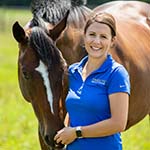Finding a feed that fits the nutritional needs of your horse is very important, but it’s just as important to ensure the feed is manufactured in a way that is safe and limits common sources of risk to your horse.
At Tribute® Superior Equine Nutrition, we have many protocols in place designed specifically with the safety of your horse in mind.
Regulatory Oversight
Guidelines published by the American Association of Feed Control Officials (AAFCO) dictate the label requirements for equine feed. You can learn a lot about a feed by reading the feed tag.
In addition to being responsible for creating label requirements, AAFCO is also responsible for determining which ingredients are allowed for use in horse feeds. These ingredients must be shown to be safe to feed to horses.
For some ingredients, they are only allowed to be used in horse feeds at certain rates. A good example of this is the ingredient chromium. Only one source of chromium has regulatory approval for use in horse feeds, and it is only approved for use at a static rate of 4 mg (maximum) per day. Chromium included in horse feeds that are fed at a variable rate that can exceed 4 mg per day of chromium intake would technically not follow AAFCO regulations.
Individual states can also enact specific regulations that are required to be met for a horse feed to be registered for sale.
It is important to note that supplements are not held to these standards.
Ingredient Selection and Quality
While AAFCO has oversight on which ingredients are allowable in equine feeds, they don’t require specific testing or quality parameters to be followed for approved ingredients.
For example, dried distillers grains (DDGS) are an approved feed ingredient for use in horse feed. Dried distillers grains are a byproduct of the ethanol industry. The starch in corn is fermented to create ethanol and dried distillers grains are what is left after this process is complete. The non-starch nutrients in dried distillers grains are concentrated in the end product, making this a high protein and low NSC (non-structural carbohydrates; sugar + starch) ingredient; however, mycotoxins are also concentrated in DDGS and can be very detrimental to horse health. Depending on growing conditions, there will be years when the mycotoxin load in corn is very high and it is difficult to source DDGS that would be safe for horses to eat. For that reason, we have chosen not to utilize DDGS in Tribute® products.
This is only one example of the thought process that goes into choosing quality ingredients to use in Tribute® products, which goes well beyond the regulatory requirements. All ingredients used in Tribute® products are purchased from trusted suppliers and undergo extensive quality testing.
Ionophore-Free
Ionophores are medications that are used in feed for various livestock species, such as beef cattle, swine, and poultry. They have an important role in supporting health and feeding performance in those species, but horses are highly sensitive to even very small quantities of ionophore contamination.
Some mills use sequencing or flushing to try to limit the likelihood of crossover of horse feed with feeds containing ionophores, but this still allows for the risk of contamination. Tribute’s horse feed is 100% ionophore-free, and it is for this reason that we built a facility completely free of any ingredients that may be harmful to horses, including ionophores to eliminate the risk of putting any horse’s health in jeopardy.
Quality Assurance
Quality assurance also extends to the physical appearance and texture of horse feed. Each feed undergoes multiple quality checks throughout the manufacturing and bagging process and every bag is labeled with individual lot tracking information, which allows full visibility on the entire manufacturing process for each individual bag of Tribute® horse feed.
We take great pride in creating nutritionally balanced, high quality and SAFE feeds for your horse. If you have questions about your horse’s feeding program, please contact us for a free, personalized feeding plan.

